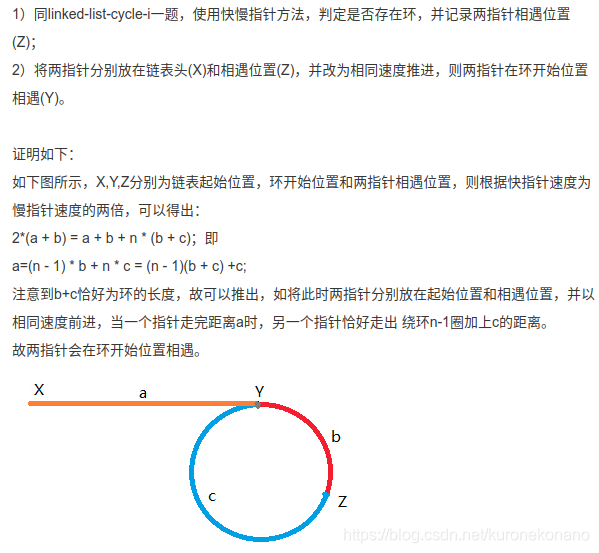给定一个链表,返回链表开始入环的第一个节点。 如果链表无环,则返回 null。
为了表示给定链表中的环,我们使用整数 pos 来表示链表尾连接到链表中的位置(索引从 0 开始)。 如果 pos 是 -1,则在该链表中没有环。
说明:不允许修改给定的链表。
示例 1:
输入:head = [3,2,0,-4], pos = 1
输出:tail connects to node index 1
解释:链表中有一个环,其尾部连接到第二个节点。
示例 2:
输入:head = [1,2], pos = 0
输出:tail connects to node index 0
解释:链表中有一个环,其尾部连接到第一个节点。
示例 3:
输入:head = [1], pos = -1
输出:no cycle
解释:链表中没有环。
来源:力扣(LeetCode)
链接:https://leetcode-cn.com/problems/linked-list-cycle-ii
著作权归领扣网络所有。商业转载请联系官方授权,非商业转载请注明出处。
思路: 整个过程为,使用快慢指针,慢指针每轮走一个节点,快指针每轮走两个节点,若存在环,快指针与慢指针必定相遇. 相遇后,快指针(或慢指针)回到链表头节点,之后开始同时每次走一个节点,当慢指针与快指针再次相遇时,相遇点为链表环的入口.
当然此方法可以判断链表是否有环,当快慢指针第一次相遇即可说明有环.
判环代码如下:
/**
* Definition for singly-linked list.
* struct ListNode {
* int val;
* ListNode *next;
* ListNode(int x) : val(x), next(NULL) {}
* };
*/
class Solution {
public:
bool hasCycle(ListNode *head) {
ListNode *slow=head;
ListNode *fast=head;
while(slow!=nullptr&&fast->next!=nullptr)
{
slow=slow->next;
fast=fast->next->next;
if(fast==nullptr)return false;
if(slow==fast)return true;
}
return false;
}
};
找到环的入口节点的原理证明如下:

代码如下:
/**
* Definition for singly-linked list.
* struct ListNode {
* int val;
* ListNode *next;
* ListNode(int x) : val(x), next(NULL) {}
* };
*/
class Solution {
public:
ListNode *detectCycle(ListNode *head) {
ListNode *slow=head;
ListNode *fast=head;
while(slow!=nullptr&&fast->next!=nullptr)
{
slow=slow->next;
fast=fast->next->next;
if(fast==nullptr)return nullptr;
if(slow==fast)break;
}
if(slow==nullptr||fast->next==nullptr)return nullptr;
fast=head;
while(slow!=fast)
{
slow=slow->next;
fast=fast->next;
}
return slow;
}
};